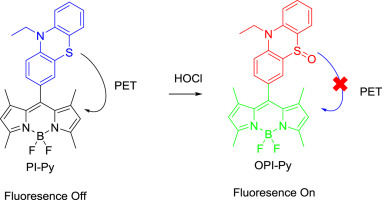Dyes and Pigments ( IF 4.1 ) Pub Date : 2020-01-08 , DOI: 10.1016/j.dyepig.2020.108192 Hongfang Li , Yu Miao , Zhixue Liu , Xue Wu , Chunxiang Piao , Xin Zhou

|
A fast-responsive fluorescent probe PI-Py was designed and synthesized for sensitive and selective detecting hypochlorite (ClO−). The probe PI-Py was intrinsically non-fluorescent due to the PET effect of the phenothiazine moiety. After reacting with ClO−, the PET effect was blocked, and a strong green emission of the BODIPY unit was recovered. The probe PI-Py showed an excellent selectivity towards ClO− in comparison of other ROS. The limit of detection for ClO− was calculated to be 1.7 nM, proving the probe's high sensitivity. Moreover, the probe PI-Py has been proved to be effective in visualizing the variations of exogenous ClO− in living HeLa cells. A co-localization study employing Mito Tracker red reveals that the PI-Py is specifically located in the mitochondria.
中文翻译:

线粒体靶向荧光探针可快速检测活细胞中的次氯酸盐
一个快速响应性荧光探针PI-PY的设计和用于灵敏的和选择性检测次氯酸盐(CLO合成- )。由于吩噻嗪部分的PET效应,探针PI-Py本质上不发荧光。与CLO反应后-中,PET作用被阻断,并回收BODIPY单元的强绿色发光。探针PI-PY表明朝向CLO优异的选择性-在其他ROS的比较。检测CLO的极限-经计算为1.7纳米,证明探头的高灵敏度。此外,探针P1-PY已被证明是有效的可视外源CLO的变化-在活的HeLa细胞中。一项使用Mito Tracker red的共同定位研究表明,PI-Py特别位于线粒体中。











































 京公网安备 11010802027423号
京公网安备 11010802027423号